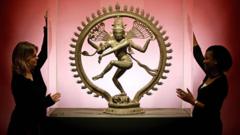In the 11th century, King Rajaraja Chola commissioned the colossal Brihadishvara temple, an architectural marvel that soars to 216 feet and was constructed using 130,000 tonnes of granite. Enshrined within this temple was a grand figure of the Hindu god Shiva, adorned with gold, rubies, and pearls. This temple not only served as a religious center but also a symbol of the Chola’s immense wealth, acquired through conquests and effective resource management.
The Chola dynasty emerged as formidable innovators in an era dominated by petty disputes among regional powers in southern India. The prominent royal women, like Rajaraja’s great-aunt Sembiyan Mahadevi, helped create a devoted following for the Cholas by enhancing temples and making the figure of Nataraja—Shiva as the Lord of Dance—a central theme, which endures as a significant symbol of Hinduism today.
As Rajaraja expanded his territory into Lanka and beyond in the 990s, his reign brought remarkable advancements in public works and agriculture, using the bounty from conquests to fund irrigation systems and agriculture initiatives. This scale of economic control was unprecedented for the time.
His successor, Rajendra Chola, continued this legacy by forming alliances with Tamil merchant corporations and expanding influence overseas, particularly in Southeast Asia. Tamil merchants navigated a wave of trade that saw them establishing connections and influence from Quanzhou in China to markets in Myanmar and Thailand.
Chola cities flourished as multicultural hubs, attracting diverse groups from across continents. Their artistic achievements, particularly in metalwork, rivaled the great masters of the Renaissance and laid the groundwork for a cultural and economic behemoth in medieval times.
Today, remnants of their trading legacy and artistic brilliance are celebrated, with Chola bronzes featured in major museums around the world, serving as a reminder of a powerful dynasty that shaped global connections long before modern globalization.
The Chola dynasty emerged as formidable innovators in an era dominated by petty disputes among regional powers in southern India. The prominent royal women, like Rajaraja’s great-aunt Sembiyan Mahadevi, helped create a devoted following for the Cholas by enhancing temples and making the figure of Nataraja—Shiva as the Lord of Dance—a central theme, which endures as a significant symbol of Hinduism today.
As Rajaraja expanded his territory into Lanka and beyond in the 990s, his reign brought remarkable advancements in public works and agriculture, using the bounty from conquests to fund irrigation systems and agriculture initiatives. This scale of economic control was unprecedented for the time.
His successor, Rajendra Chola, continued this legacy by forming alliances with Tamil merchant corporations and expanding influence overseas, particularly in Southeast Asia. Tamil merchants navigated a wave of trade that saw them establishing connections and influence from Quanzhou in China to markets in Myanmar and Thailand.
Chola cities flourished as multicultural hubs, attracting diverse groups from across continents. Their artistic achievements, particularly in metalwork, rivaled the great masters of the Renaissance and laid the groundwork for a cultural and economic behemoth in medieval times.
Today, remnants of their trading legacy and artistic brilliance are celebrated, with Chola bronzes featured in major museums around the world, serving as a reminder of a powerful dynasty that shaped global connections long before modern globalization.




















